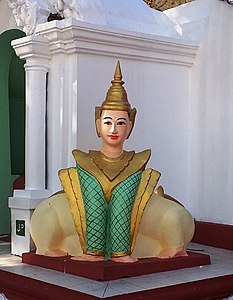Manussiha

Manussiha (
Etymology

Manussīha(မနုဿီဟ) is a combination of two Pali words; Manussa(မနုဿ) meaning "human" and Sīha(သီဟ) meaning "lion". Thus, it can be literally translated as "Man-lion".
The Myanmar-English Dictionary, published by the Myanmar Language Commission, defined မနုဿီဟ as:
မနုဿီဟ
fabulous creature with a man's torso and a lion's hindquarters, depicted in a squatting posture on forked haunches
[Pali မနုဿ + သီဟ]
History
The most famous version of history of Manussīha is from Sāsanālaṅkāya Treatises (သာသနာလင်္ကာရစာတမ်း).
In 235th year after
There are different versions of that history, only different in stating the name and location of the capital city of Suvaṇṇabhūmi. Sadhuim is the short form of Suddhammapura. Some sources say the capital city is Suddhammavati. Some other authoritative sources say that its name was Taikkala (from Golamatti in Pali, through Mon-Tuik gala). The authoritative sources states that half of the city was located on top of Mount Kelasa while the rest was on the adjoining plain.[1]
Gallery
-
Manussiha sculpture at Myat Saw Nyi Naung Pagoda
-
Manussiha in a book about Nats
-
The planetary post for Tuesday, associated with the lion, at the Shwedagon Pagoda. A Burmese sphinx[8] (Manussiha) statue stands in the background.
-
A Manussiha statue in Sambuddhe Pagoda
Notes
- ^
- MLCTS: ma.nu.ssiha.
- ALA-LC: manussīha
- BGN/PCGN: manuthiha / manokthiha / manotthiha / ma note thiha
- ^ manuk siha
- ^ In 1193 ME (1831 CE), by the order of the King Mindon, the interior minister and governor of Hsaw Thiri Maha Nanda Thingyan (Sīrimahānandasaṅkran) asked questions and the king's counselor minister Maha Dhamma Thingyan (Mahādhammasaṅkran) answered them , referencing on various canons and scriptures, then the questions and answers were written as the treatises and read out in the royal court. The treatises was clarified and published by Rangoon Hanthawadyy Pitakat Press in 1956.
- ^ The Sāsanālaṅkāya Treatises, clarified and first published in 1956, states that this rock Manussīha statue still existing there. Someone should prove whether the statue is still existing.
References
- ^ a b "Manussiha, the Man-lion - Myanmar Religion and Beliefs". Archived from the original on 2009-02-27. Retrieved 2010-06-19.
- ISBN 9780349124339.
- ISBN 9783825821869.
- ^ "The Board of Trustees of Shwedagon Pagoda". shwedagonpagoda.com.
- ^ "SECURITY OFFICER CARRIES ANTI-DRONE GUN DURING". shutterstock.com.
- ^ Myanmar-English Official Dictionary. Department of the Myanmar Language Commission.
- ^ မဟာဓမ္မသင်္ကြန် [Maha Dhamma Thingyan] (1956). သာသနာလင်္ကာရစာတမ်း [Sāsanālaṅkāya Treatises]. Rangoon (Yangon): Hanthawadyy Pitakat Press. pp. 57–58.
- ISBN 9789352062782.



![The planetary post for Tuesday, associated with the lion, at the Shwedagon Pagoda. A Burmese sphinx[8] (Manussiha) statue stands in the background.](http://upload.wikimedia.org/wikipedia/commons/thumb/d/d4/Inga_Gyo_Taing%2C_Yangon%2C_Myanmar.jpg/453px-Inga_Gyo_Taing%2C_Yangon%2C_Myanmar.jpg)

